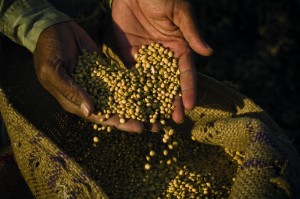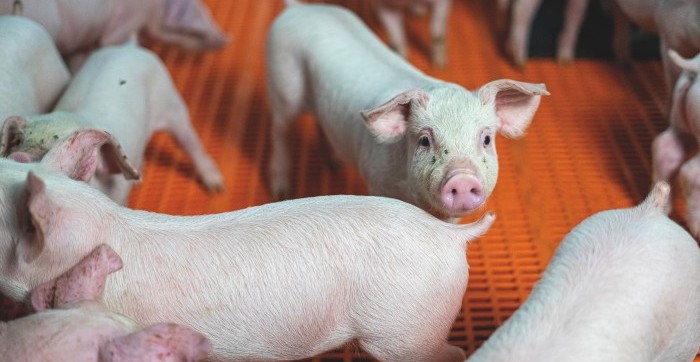With an ever-increasing focus on farming’s environmental footprint, principal National Pig Awards sponsor ForFarmers is embracing the circular approach to sustainable food production. HELEN BROTHWELL reports
Cohesive plans are being made to reduce the environmental impact of livestock production, with businesses and individuals increasingly aware that we all have a responsibility to live and work in a more sustainable way.
ForFarmers is taking a leading role in the industry’s discussions and has developed plans for a positive way forward, which recognise the important role of livestock in sustainable food systems. The fact that animals can transform low-value materials into high-value food forms the first part of ForFarmers’ circular approach, outlined in its new sustainability strategy ‘Going Circular, For the Future of Farming’.
The strategy is also focused on using or reusing by-products and co-products, which animals are also very good at, to avoid wasting resources. The third ambition is to achieve zero pollution from CO₂, nitrogen and phosphates to mitigate climate change and protect soil health and water quality.
“The circular approach to sustainable food production is widely referred to by academics internationally and ForFarmers is keen to embrace it,” said the company’s corporate affairs director Nick Major.
“It addresses society’s land use debate and I think increasing the percentage of non-human edible materials used in livestock production will be an important indicator of our progress. It solves one of our biggest challenges, as we can show we’re not using land that could have been used to directly feed the human population.”
New market reality

“We have to acknowledge concerns about emissions from food production and keep an open ear to anticipate changing views,” said Mr Major. “The worry remains that the livestock sector will be asked to do more while not being paid for it – however we can’t ignore the new market reality.”
Sustainable sourcing of soya is a big issue for the pig industry. Soya will always be an important source of digestible amino acids for pig diets but sustainability is essential so that livestock production does not contribute to deforestation. “ForFarmers works within FEFAC (which represents the European feed industry) Soy Sourcing Guidelines and has an objective for all soya and palm oil to be responsibly sourced by 2025,” said Mr Major.
“Climate change is also a priority and ForFarmers is hugely supportive of helping to reach the NFU’s goal for agriculture to achieve net zero greenhouse gas emissions by 2040.”
Animal feed makes up a significant proportion of a farm’s carbon footprint and the Going Circular strategy is about helping farmers reduce the overall footprint of producing a kilogram of pork or beef, for example. It outlines three focus areas: feed resources, feed production and feed solutions.
 “Something like 90% of animal feed’s emissions come from raw materials – hence our work on responsible sourcing and use of non-human edibles, while 10% come from feed production, our own feed manufacture and transport operations, Mr Major said.
“Something like 90% of animal feed’s emissions come from raw materials – hence our work on responsible sourcing and use of non-human edibles, while 10% come from feed production, our own feed manufacture and transport operations, Mr Major said.
“We plan to make our largest feed mill carbon neutral by 2025, as proof of concept, and work towards a 75% reduction in C02 per tonne of feed from production and transport across the business by 2030. Purchasing energy efficient machines and installations and installing solar panels, are examples of actions it can take.”
On-farm support
“The feed solutions part is our on-farm support, formulating diets that give the optimum feed efficiency, while considering animal health and welfare and breeding performance too,” Mr Major added.
“We can also offer advice on different materials and what can be substituted where appropriate.There will come a point when farmers will want or need to say what their carbon footprint is. ForFarmers can already provide customers with the carbon footprint of the feed it supplies.
“The tricky part is finding the right balance between all the aspects of pig management and feed production. A diet which is optimal for feed conversion ratio and carbon footprint, for example, might use more energy to manufacture. There are also societal limits and expectations to take into account, such as consumer preferences for outdoor produced pork.
“There are always going to be a range of pig production systems and ForFarmers’ aim is to help all farmers improve circularity and efficiency in whichever system they use.”
Alternative proteins
There are some interesting alternatives to soya that have passed the proof of concept stage and could be useful in providing a proportion of dietary protein in future.

ForFarmers is involved in ongoing research into synthetic amino acids, algae and insects, among others, alongside feeding co-products. “Extensive trials on key synthetic amino acids show that each new one that is developed gives a 1% reduction in dietary soya,” said Ad van Wesel, head of ForFarmers’ Nutrition Innovation Centre.
They could enable us to deliver the ideal profile of amino acids so we would need only 7.5% protein in the diet rather than 14%. That would also help reduce ammonia emissions from urine.”
Buckwheat is another interesting protein alternative, although fungi are problematic when growing the crop more intensively. GM technology would help solve this problem but is not currently legal in the EU.
Insects, already used for pets and aquatics, provide another good quality source of protein, but are not yet permitted for use in large animal diets. “We’re keeping an eye on it, although it will probably be five to 10 years before a legal change and it also needs to be economical,” said Mr van Wesel.
“The substrate will be an important factor too – it will be more valuable to a circular system if insects can be grown on waste materials that couldn’t be used elsewhere.”
Single-cell proteins such as algae are probably closer to being fed to pigs than insects and there are several algae products on the market with a similar protein quality to soya. The price is still much higher, but it is going down and there is also the benefit that algae can sequester CO2.
Co-products in liquid-fed pig systems will remain important and probably increase further, particularly is a small country like the Netherlands where it is easier to minimise transport costs. They now make up more than 40% of pig feed produced in Britain. “It makes both commercial sense and fits with sustainability aims,” said Mr van Wesel. “Another option for the UK is to ferment wheat before feeding in liquid systems as it improves its digestibility so that less protein is needed.”
Mr van Wesel emphasised that, on all farms, precision feeding is the most important step to improve feed conversion efficiency. “Farmers need knowledge of what the pigs require so they can feed more accurately – if we know the data, we know what to do. It’s a moving target with changing genetics and environment, so you have to measure performance routinely. In-pen weighing scales are very useful.”
The NFU’s goal of achieving net zero for agriculture by 2040 has made it imperative to take action, while a report from the Centre for Innovation Excellence in Livestock (CIEL) on ‘Net Zero Carbon and UK Livestock’ discussed options, including mitigation of feed ingredients.
“ForFarmers wants to help the industry realise the opportunities as well as the challenges,” said Mr Major. “The market needs to send the right signals too and incentivise producers by rewarding them.
“Hopefully supply chains are becoming more collaborative and the government can help bring organisations together, as it did with the UK Roundtable on Sustainable Soya. Going Circular cannot be achieved by one company – we all have to work together.”




